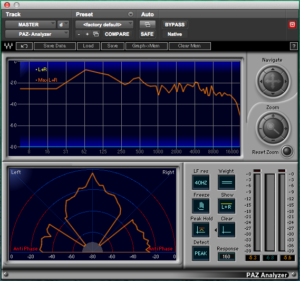Step One: Seeing Sound
From early on in my musical career, I have visualized mixes as sonic paintings. Arguably, “seeing the sound” is as instantaneous as listening: right away, our imagination translates what is heard into some sort of visual representation. As a critical listener, I notice my brain perceives some instruments very literally. For example, when I analyze percussion within a mix, such as high hats, my visual imagination automatically responds by “painting” an actual high hat, or a snare – or tom. For other sounds such as vocals, what I visualize while listening can be very abstract, and sometimes impossible to describe beyond “energetic shapes of frequencies.” Ultimately, any critical listener’s imagined sonic painting will be different; however, as a mix engineer, getting lost within a sonic painting is not an option. There is a right way to build, deconstruct, and holistically analyze a sonic painting. In the act of mixing, the engineer, more accurately, is sculpting a mix rather than painting one. I believe the shape of this imaginary sculpture of sound is best described by a pyramid. In light of “seeing the sound” technically and professionally, sculpting the “sonic pyramid” is one of the best philosophies I have ever put into practice – for making mix decisions on individual instruments (the pyramid steps leading to the top), and the mix as a whole (the pyramid altogether).
The Pyramid Position and the Studio Monitors

Picture an equilateral triangle of sound in front of both the left and right studio monitors (and possibly a subwoofer underneath, if you have one). The left and right studio monitors are half way between the top and bottom of the imaginary triangle, and below this triangle is your subwoofer. In turn, the triangle is widest toward its base, where the subwoofer is. Above the left and right monitors, the triangle reaches finally comes to its peak. So now we have a triangle positioned with respect to the speakers – stay with me here!
Frequencies within the Pyramid: Where they Go and How Loud they Should Be
Audible frequencies range from 20 Hertz to 20,000 Hertz. Essentially, the golden rule of the sound pyramid is that low frequencies make up the bottom and are loudest, while high frequencies belong at the top and are lowest in volume. Theoretically, the peak of the pyramid is 20,000 Hertz, and the pyramid base is 20 Hertz. In turn, as the sonic pyramid ascends from bottom to top, frequencies become higher, while volume must decrease. As a result, 500Hz should be slightly louder than 1000 Hz in a mix, and 1000 Hz should be louder than 4000 Hz, and so on. In another example, a high hat made up of high frequencies should not be louder than the snare drum, made up of mid range frequency!

Above: The PAZ Analyzer from Waves applied to the master channel of a good mix reflects a downward frequency spectrum: volume gradually decreases as frequency increases.
Sculpting the Pyramid:
I hear lots of poorly mixed music from the internet where, frankly, the sonic pyramid is nowhere near existent: beats have piercing high hats as loud as the bass drums, or the vocal is extremely loud and stepping over the mix. In reality, once the pyramid is visualized, it becomes an easy mental strategy to use with tools such as EQ. The great thing about constructing the mix with the pyramid is the way in which relationships between instruments become conceptualized, since each frequency range is occupying an exact position within the pyramid. With this in mind, you begin to EQ, and compress soloed instruments, but still make decisions with the mix as a whole in mind. See the sound – and the precise geometry of each frequency’s pocket in the mix: the kick is louder and near the bottom of the sonic pyramid you see; the snare is less intense, near the middle, going up the pyramid. Moving further up the frequency spectrum, the same goes for snares and hi hats: snares should be louder than high hats containing higher frequencies, and below them in the pyramid as a result. If two sounds share a similar frequency range, or pocket in the pyramid, as snares and vocals sometimes do, adjust your faders so they are equally intense, but never fighting for frequency content. Overall, for each instrument, consider its most musical frequency and pocket it into your pyramid. Adjust the instrument(s) of the pyramid pockets with an equalizer, and compress instruments interfering with adjacent pockets higher up in the pyramid. For example, if your mix contains a bass guitar and piano, your piano should not contain lower frequencies interfering with the bass’ space in the pyramid. The piano belongs in the mids and its low end content may need be be removed with EQ, or controlled with compression.
All in all, next time you hear a mix from a great engineer, where all instruments are present, rich, and not fighting for space, observe the pyramid scheme at work. Once you understand the pyramid scheme, it should be impossible to see the sound of a mix any other way in front of studio monitors, or any speaker for that matter. As abstract as your sonic vision may be, never will you ever “see” a kick drum on top of a high hat.
Chris Baylaender
Studio 11

Comments.
Currently there are no comments related to this article. You have a special honor to be the first commenter. Thanks!